Fall in Vermont’s Mad River Valley | Turn Up the Color
The beauty of Vermont’s Mad River Valley is no secret, but seeing it painted in autumn hues brings a feeling of discovery.
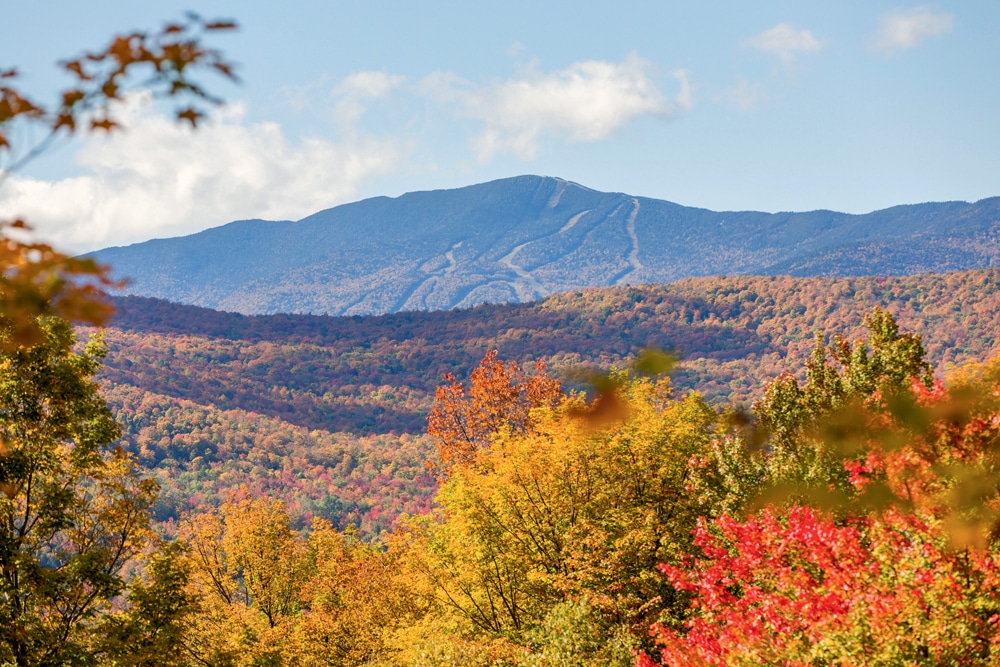
Coffee By Design | Portland, Maine
Photo Credit : Katherine Keenan
Photo Credit : Oliver Parini
That was the first theory I heard about the Mad River’s name, and in the end, it was my favorite. The wayward water courses up from Granville Notch, deep in the Green Mountains, and tumbles through a picturesque Vermont valley dotted with villages, red barns, and church steeples, until it finishes just north of Montpelier, with an exhale into the Winooski River.
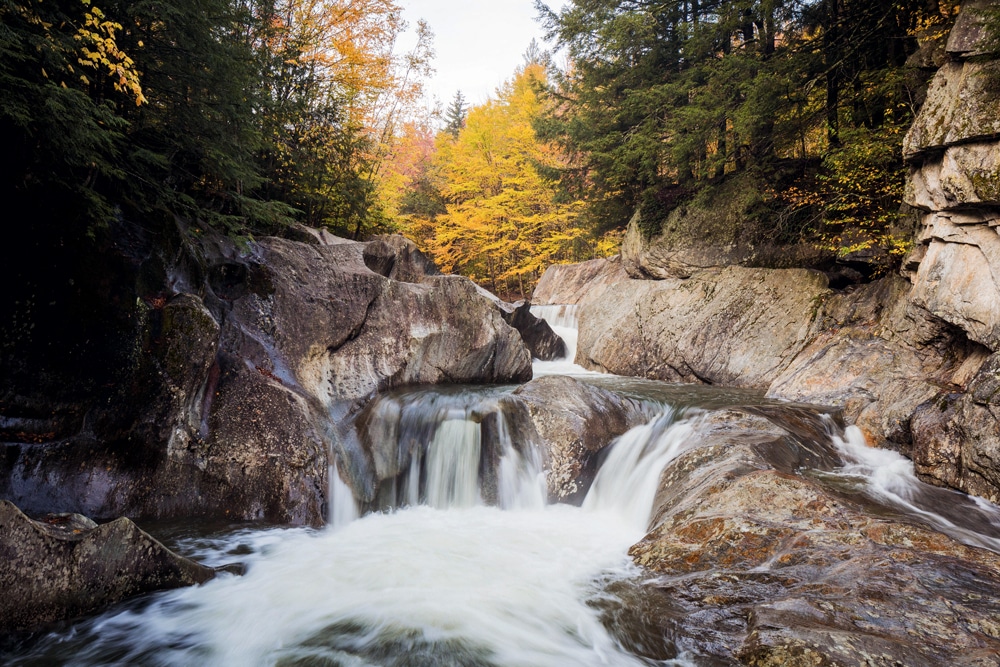
Photo Credit : Oliver Parini
Along the way, it carves its initials into the land, with swimming holes and fishing nooks. It pops up when you least expect it, like the Where’s Waldo? of waterways. Trails hug it. Covered bridges leap over it in Waitsfield and Warren. You can bask on the riverbanks. Kayak through its stony ribs. The river bestows its name and its identity on this 144-square-mile watershed: the Mad River Valley. A tree-studded haven that hides a handful of towns … and two major ski resorts.
So it’s not exactly a travel secret—very little is, these days. But it feels undiscovered, as I roam around the valley on a gorgeous October day. Girded by Green Mountains, this is usually where skiers flock to tackle Sugarbush or the rascally Mad River Glen. Instead, we’re on the cusp of a spectacular autumn weekend. Forecasters are fairly tingling with predictions for peak. Those mountains? They’re flaming with color. The river is lit with sparks of red and yellow. Farms are edged in every shade of orange.
When people think of fall in Vermont, this is what they imagine.

Photo Credit : Oliver Parini
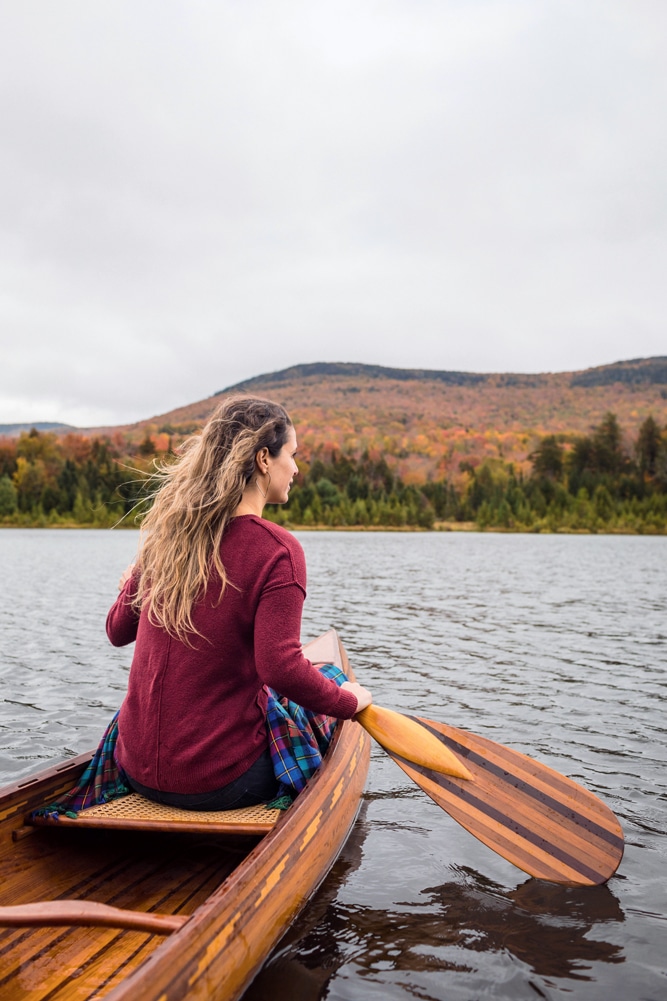
Photo Credit : Oliver Parini
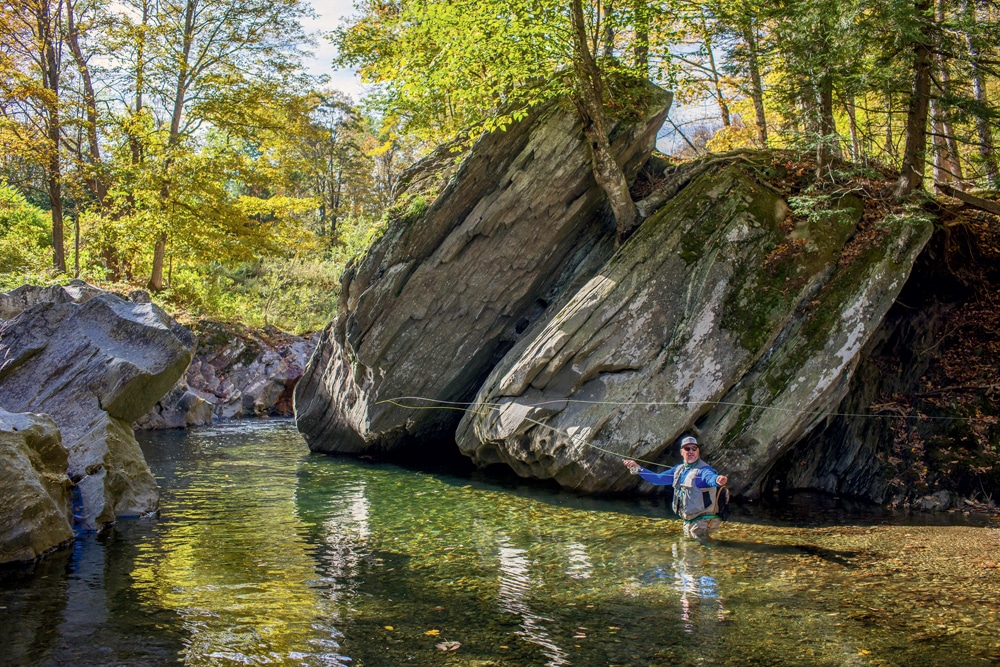
Photo Credit : Oliver Parini
This is a trip to say yes. I’ll take a deep dive into the Mad River Valley countryside, explore the main town of historic Waitsfield, and putter around in Warren Village, a picture-pretty hamlet of 1,700 folks, but there are only a few days to soak up the colors. And although biking, hiking, and kayaking are all tempting options for playing with autumn, I’ve discovered something I never thought I would do….
Conditions must be just right for liftoff, and this mid-October day is perfect as my car scrambles up the long dirt road to Sugarbush Soaring, tucked on a plateau outside Warren Village. Blue skies above, color washing down the mountainside. I pass working farms, a collapsing silo, vast land. I’m scanning the sky for gliders.
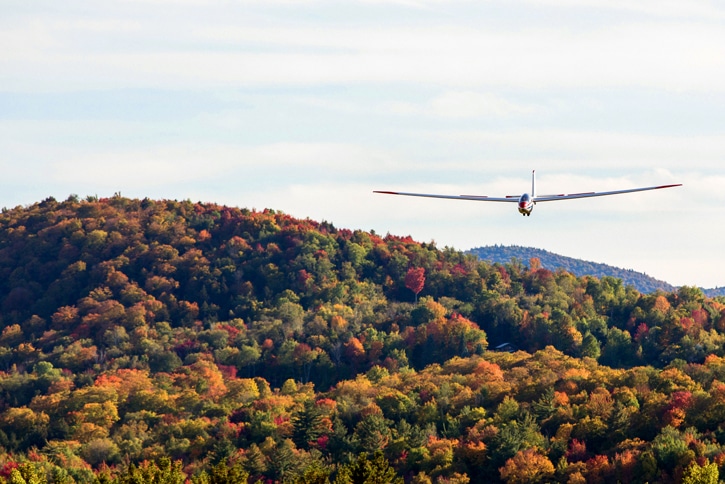
Photo Credit : Oliver Parini
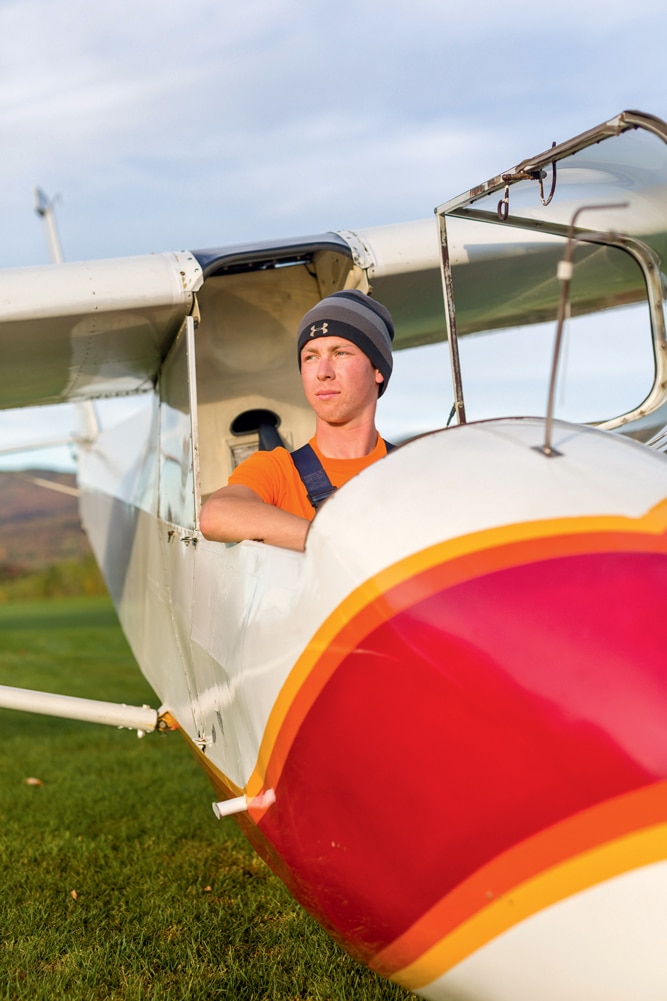
Photo Credit : Oliver Parini
Gliding enthusiasts have been drawn to the valley since the late 1950s, and today flight instructor Steve Platt will show me why. He lifts the hatch and settles me into the front seat of an ASK 21 glider. It’s the 850-pound version of the toy balsa wood airplanes we all flew as kids. It wobbles as he climbs in behind me, and he asks me to tilt my head out of the way, so he can see better. We hook up to a pugnacious Piper Pawnee crop duster. “It’s got a lot of yank to it,” says John Tracy, a veteran flier who will tow us into the sky.
Until that moment, it doesn’t feel quite real. But it feels even less real when the cable releases and we’re no longer tethered to anything with an engine. Steve is saying something about why this place is so famous among glider pilots (three kinds of lift: thermal, ridge, and the Sugarbush Wave), but I’m too busy being astounded and trying to keep my head out of his way. I have the vantage point of an eagle. The winds lift us up, the colors take us away, and for 20 minutes we float. It’s so clear we can see the Adirondacks and Lake Champlain to the west, while Mount Washington and the rest of the Whites ring the east.
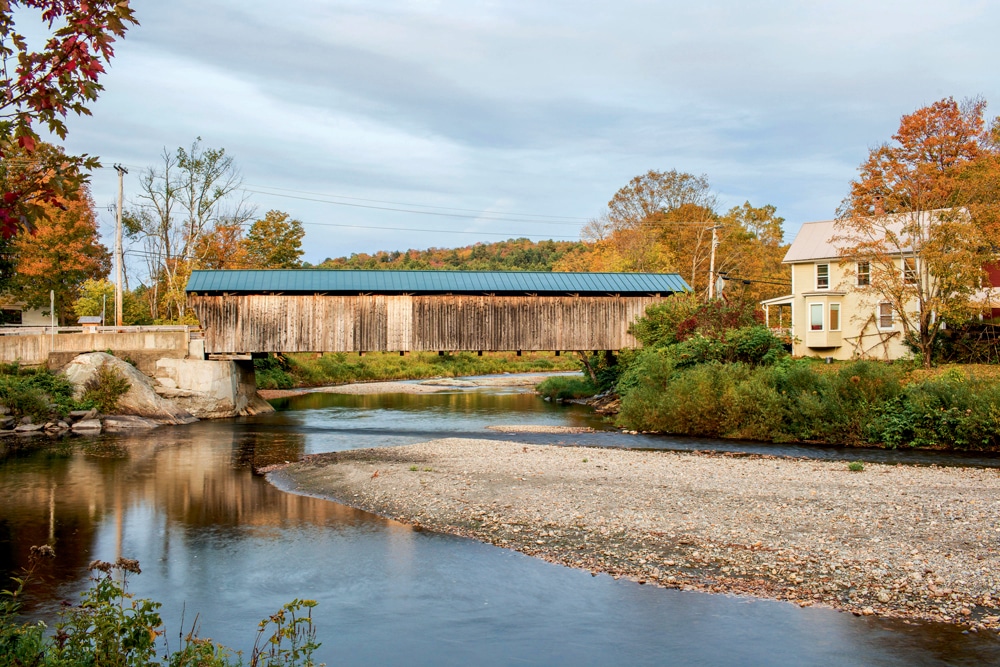
Photo Credit : Oliver Parini
When we land, there’s some talk about “peak foliage,” how it seems later this year, but Jean Tracy, John’s wife, who runs the office, voices the bittersweet truth: “We never know when peak is until it’s gone.”
It’s so easy to be beguiled by this river. It’s accessible, and it is beloved. The Friends of the Mad River, formed in 1990, regularly monitors its health: E. coli levels are posted at every swimming hole, including here, in the center of Waitsfield, where a massive sandbar bulges into the water, forming a natural beach surrounded by the river. It’s the perfect place to lounge, read, stare off into space, watch kids fish, admire the covered bridge, and stare off some more. I dangle my feet and gaze at the curves in the river, an invitation to 21st-century minds to let go of the clutter and simply look at the water, look at the leaves, be simple. Also, the Sweet Spot is very handy. If you require caffeinated beverages, a pretty garden overlooking the water, and chunky apple handmade pies, its proximity to the sandbar will make you happy.
Photo Credit : Oliver Parini

Photo Credit : Oliver Parini
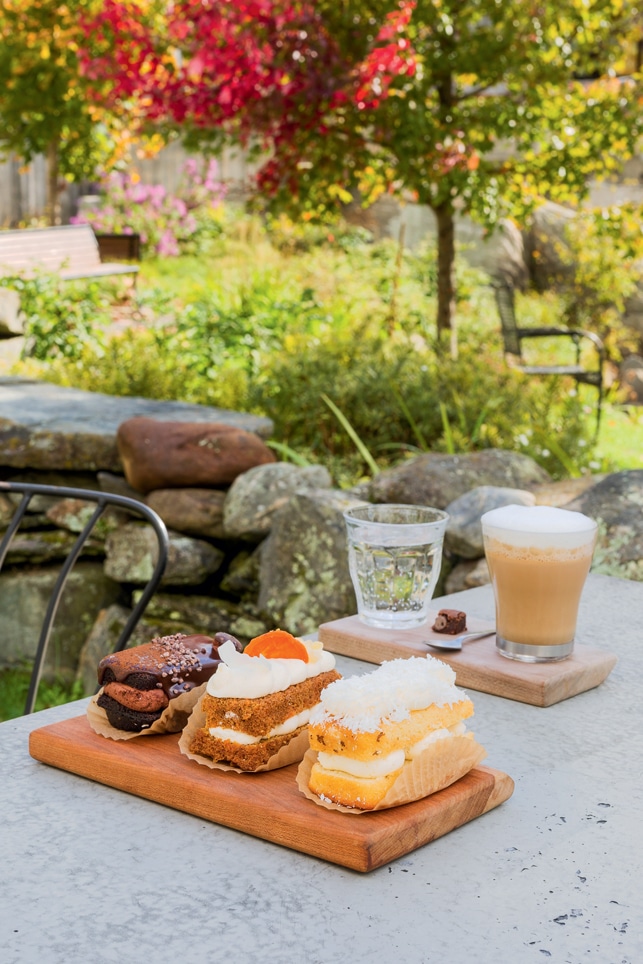
Photo Credit : Oliver Parini
Waitsfield has a population (about 1,720) that hovers close to its inception date (1782). The downtown’s collection of shops and eateries is anchored by a pretty covered bridge, but just beyond the center, the town catches its second wind, with old farm buildings converted to businesses, and a couple of small-scale shopping centers. These are home to creative endeavors like the Mad Taco, the Tempest Book Shop, and the Mad River Taste Place, where you can kiss your diet good-bye, learn about Vermont makers, and sample their artisanal cheese, bread, syrups, and chocolate.
It’s also where you’ll find the Big Picture, a combination movie theater/café/biergarten. On this warm fall afternoon, I’m sitting under a red umbrella, admiring the furnishings and the brilliant monarch butterflies floating by, reminders of my recent aerial triumph. A woman with her 7-year-old grandson tips me off to the still-warm maple-glazed doughnuts that have a local cult following. “Snag a few while you can,” she warns. “They’ll fly out.” A sticky half dozen find their way into a bag, and if it were 10 degrees warmer, I’d probably head to one of the local swimming holes to rinse off the residue. As it is, it’s time to walk. The nearby boardwalk outside Lawson’s Finest Liquids, a microbrewery housed in a magnificent post-and-beam building, offers a semicurated walk through the wetlands that fill with puddles when storm clouds over the mountains open up and drench the land. As I will soon find out.
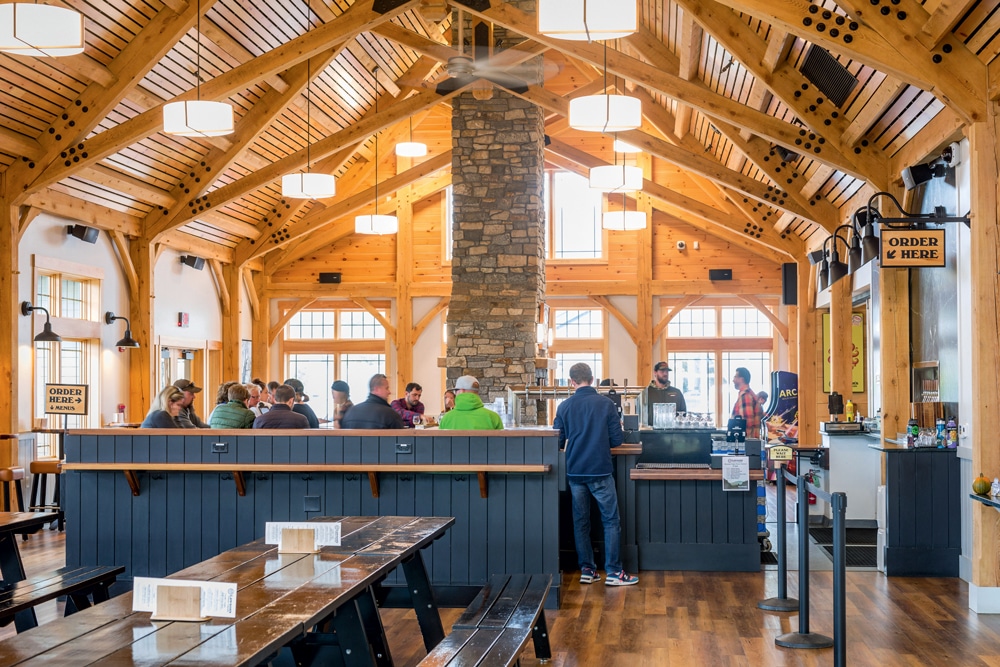
Photo Credit : Oliver Parini
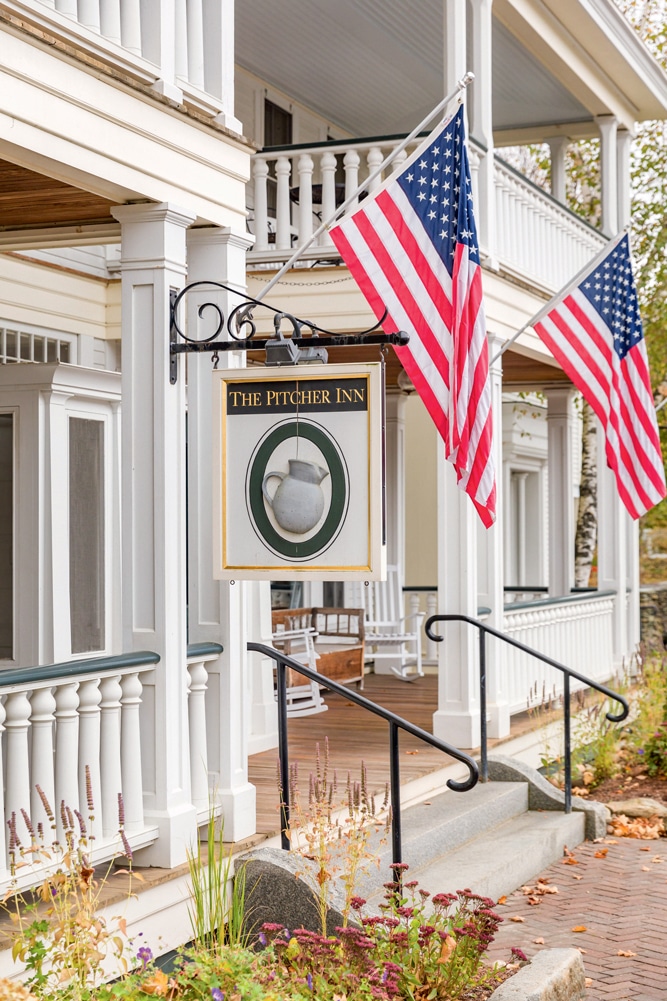
Photo Credit : Oliver Parini

Photo Credit : Oliver Parini
All I can say is that if you ever experience bombogenesis, I hope you’re stranded at the Pitcher Inn, in the heart of minuscule Warren Village. The deliciously understated Relais & Châteaux retreat is the psychological equivalent of a deep dive into a Vermont Flannel blanket—which, by the way, shows up for my in-room picnic, complete with charcuterie, in front of a crackling fire.
The skies opened, the rain poured down, and I was happily holed up in the Mountain Room, paneled with sheets of rock, with a plump bed set inside a replica of a fire tower. Chef Jacob Ennis roasted Brussels sprouts and flavored the squash soup with horseradish cream and juniper oil. Comfort food was redefined as pappardelle pasta laced with cauliflower cream. That night, there was a bedside chocolate cookie of rugged mountain density and proportion.
Across the street from the inn, the Warren Store, a former stagecoach stop, affords a ringside seat on the river. At first glance, it’s a small general store that’s “Almost World Famous,” jokes the sign. Dig deeper. You’ll encounter fresh-baked bread, a full-blown deli, cookies and tarts, and provisions from homemade granola to pickles. That’s just the downstairs. Go upstairs, I was told by a local, “and you can goddamn me later.” A deluge of clothing, home goods, and fine kids’ stuff.
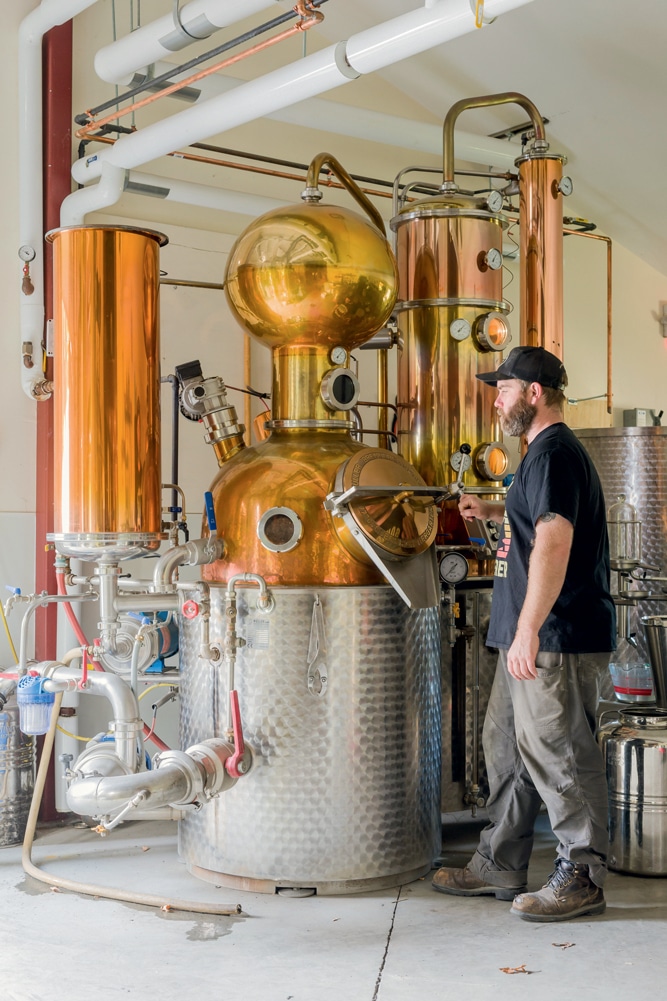
Photo Credit : Oliver Parini
The Day of Bombogenesis is also the day I was booked to see foliage while ambling through the landscape on the back of an Icelandic horse. Tucked away in the town of Fayston, at the northern end of Waitsfield, is the Vermont Icelandic Horse Farm. I’d visited earlier and met owner Karen Winhold, who has led trail rides here for more than three decades. Large, dark eyes peered out from under shaggy bangs, and the powerful thighs on these rugged mounts attest to a history of stamina. Icelandic horses, bred by the Vikings to negotiate challenging terrain, are known for their smooth gait and cheerful temperament. More important, they are said to be patient with beginners. I had read that riding an Icelandic horse can feel almost like gliding. But the fierce rains have come between us, and I’ll have to wait for another day.
Before I leave the valley, I catch the tail end of the Saturday Waitsfield Farmers’ Market. This one’s special—a good farmers’ market is a barometer of community vibrancy, and today the band is rocking out while a toddler dressed like Snow White dances along. It’s a happy tent village replete with ancient grains, Taiwanese noodles, Gizmo’s pickles, leather belts, and a bounty of cheeses, spread out over the Mad River Green, encircled by the autumn colors that have been my constant companions.
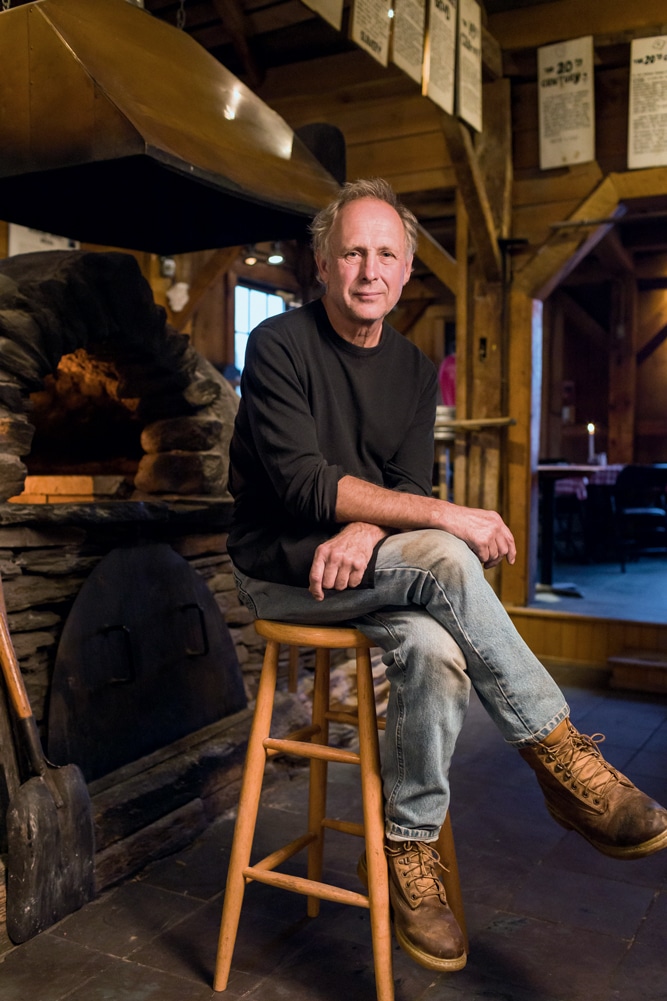
Photo Credit : Oliver Parini
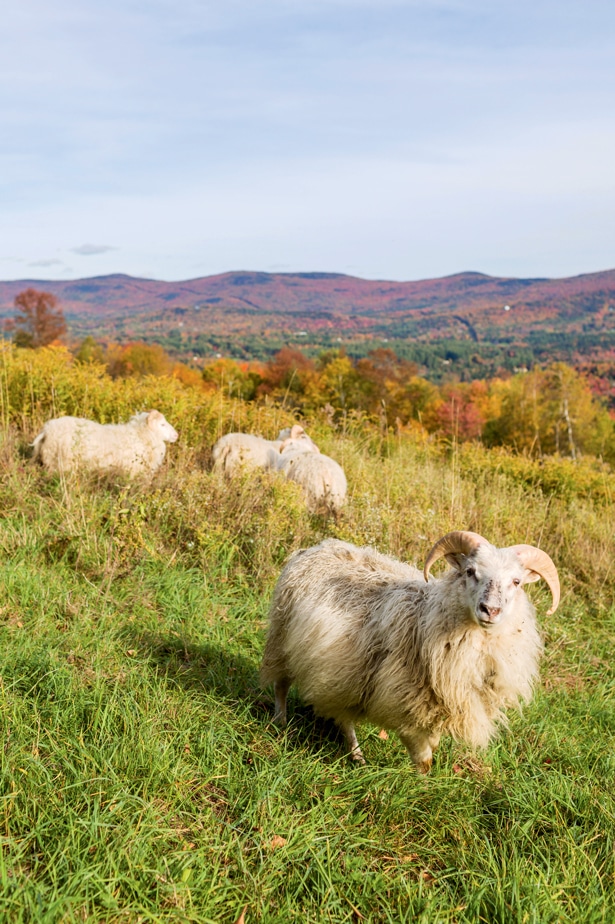
Photo Credit : Oliver Parini
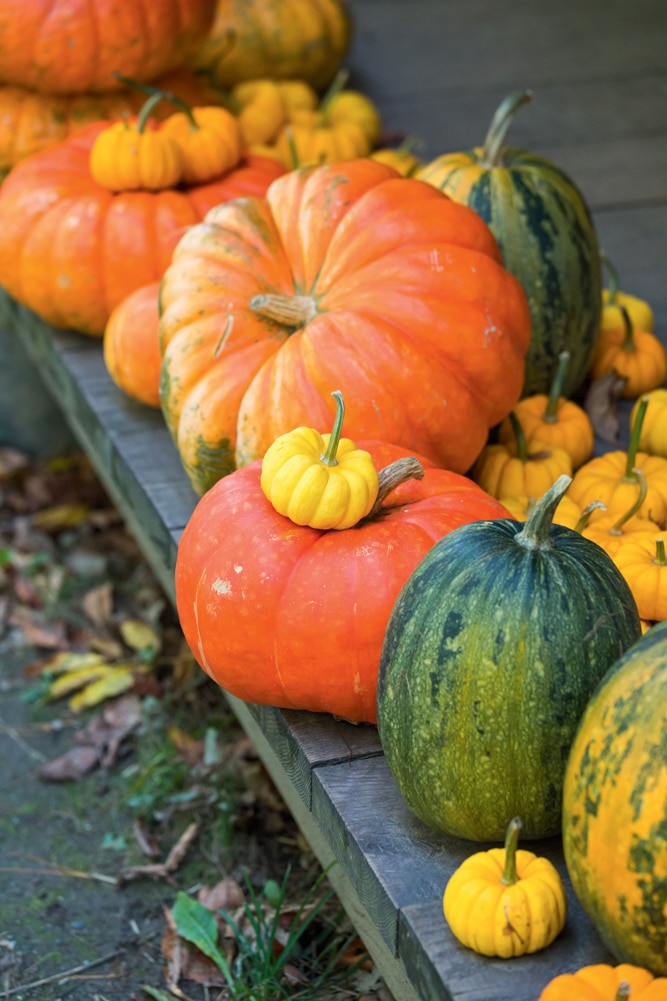
Photo Credit : Oliver Parini
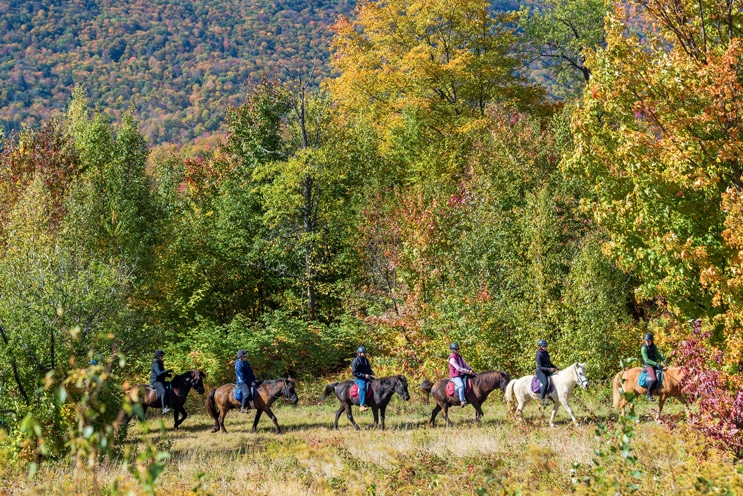
Photo Credit : Oliver Parini
But I’m still not satiated. So I’ll make one last stop, a short dash away, at the original home of American Flatbread, on the Lareau Farm property. George Schenk opened his foodie mecca in 1985, and the feel-good vibe is baked into its bones. A hulking earthen oven sits center stage, open-mouthed, waiting for flatbread pizzas loaded with fresh ingredients that burst with flavor. Mine will be curried cauliflower with turmeric potatoes; I watch it go into the oven, five searing minutes and it’s done. Parents guide their kids closer to watch. The simplicity of food and fire. Food theater. The room is warm with goodness.
Van Morrison’s “Dancing in the Moonlight” is playing as I slide out into the night, filled with honest food and the best of this Mad River Valley. It’s dark, the colors are asleep, but the feeling, in Van’s words, is warm and bright. And I know the river knows.
Mad River Valley Foliage Drive
There are countless country drives that could also entice cyclists, hikers, and walkers, but one of my favorite loops was right under my nose. Starting in downtown Waitsfield, I crossed the covered bridge, and took off up East Warren Road, past the Inn at Round Barn Farm, a historic property that epitomizes the Vermont farm fantasy, complete with knowledgeable innkeeper Kim Donahue (who keeps her finger on the pulse of foliage). A quick left down Common Road, and I found myself in a riot of color, until turning left, on Joslin Hill Road, and circling back to East Warren Road.
And don’t get me started on the notches, the ultimately perfect word to describe these rugged mountain passes. A stop at the Waitsfield Visitors Center will yield all kinds of drive ideas, but switch-backing up Lincoln Gap Road, with its gulp-worthy dropoffs and vistas, is like slicing through golden air, breathing in molecules of light.




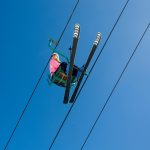

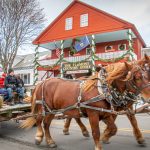

Such beautiful pictures. Vermont is an extremely gorgeous every season (even mud season)
My bags are packed! Just what my husband and I need in covid times, but he will skip the horseback ride and squash soup.
I am so pleased to be receiving the Yankee emails again. Thank you. Carolyn Foster
This was obviously written prior to fall 2020. It is out of date and misleading. COVID has changed conditions in the MRV. Many businesses, including those mentioned in this article are either closed or operating under COVID related restrictions such as extremely limited capacity, no indoor dining, or closed completely. There is a mast mandate and some visitors are required to quarantine. We who live in the MRV welcome visitors but this magazine should update this article or at least include a disclaimer stating that conditions have changed so people are not disappointed by misleading information.
Hi Claire. This assignment was written and photographed in the autumn of 2019 for publication in 2020. Understandably, businesses across New England — including those mentioned in this feature — have had to reevaluate their operations in light of COVID-19. For the most up-to-date information on travel, offerings, and openings, readers should always consult state guidelines and check with businesses directly before making travel plans. We will add a note to the top of the feature. Thank you for your comment!
We live in Vermont, and the Mad River Valley is our favorite place to vacation in Vermont, in any season, by far. It’s a little utopia that you that is iconic Vermont and has a HUGE farmer’s market every Saturday with live music, it’s like a festival every weekend. We stay at the Stars Hollow Chalet in Fayston. We picnic at Knoll Farm, which has the most gorgeous views and delicious baskets, swim in the MANY swim holes, get delicious lobster rolls at the beautiful Round Barn. In the fall you can’t NOT find foliage, it’s everywhere because you’re in a valley. You can also go to MRG or Sugarbush for foliage lift rides. It’s seriously the most beautiful area in Vermont, and iconic Route 100 runs right through it.